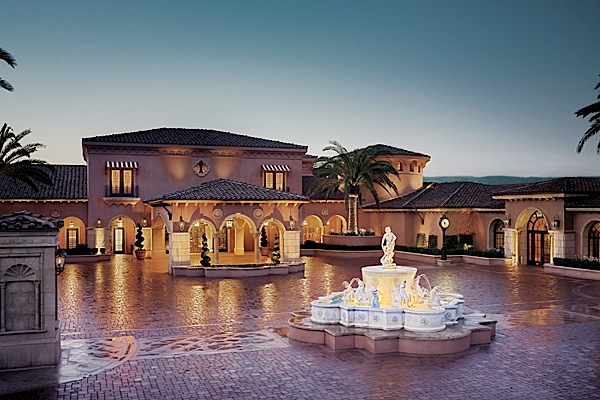MARIANI’SVirtual Gourmet
October 9, 2011
NEWSLETTER

Ralph Kramden (Jackie Gleason) and Ed Norton (Art Carney) in "Better Living Through TV," The Honeymooners (Nov. 12, 1955)
Follow @VirtualGourmet
THIS WEEK
GRAND DEL MAR
by Carey Sweet
NEW YORK CORNER: LA MAR CEBICHERIA PERUANA
by John Mariani
MAN ABOUT TOWN: PUT PIEDMONT ON YOUR SHORTLIST
by Christopher Mariani
WINE: FAST LEARNERS, CHILEAN WINEMAKERS ARE NOW
MAKING DISTINCTIVE WHITES
by John Mariani
THIS WEEK: The Michelin Man Yawns into NYC
I
almost expected to peer into the horse stall and see
a room service tray (baby carrots, apple du jour)
and a bed of straw with a pillow topped by a mint
flavored sugar cube. The amenities offered at The Grand
Del Mar are
luxurious enough to periodically feel almost absurd,
and so, too, is the posh pleasure found with the
northern San Diego County resort’s newest
attraction: a 20,000-square-foot equestrian center
that debuted in March.
Since opening in 2007, "The Grand"
has striven to live up to its name. Nestled on the
edge of the Los Peñasquitos Canyon Preserve,
the privately-owned Mediterranean estate features a
Tom Fazio-designed championship golf course, six
restaurants, its own nightclub, a Forbes Five-Star
spa with crystal glass tiles, a beauty salon, a
helipad, a world class wine cellar and library, four
pools, two tennis courts, its own chapel, and
fantastic gardens accented with statues and a 75-foot
long, 22-nozzle marble fountain. 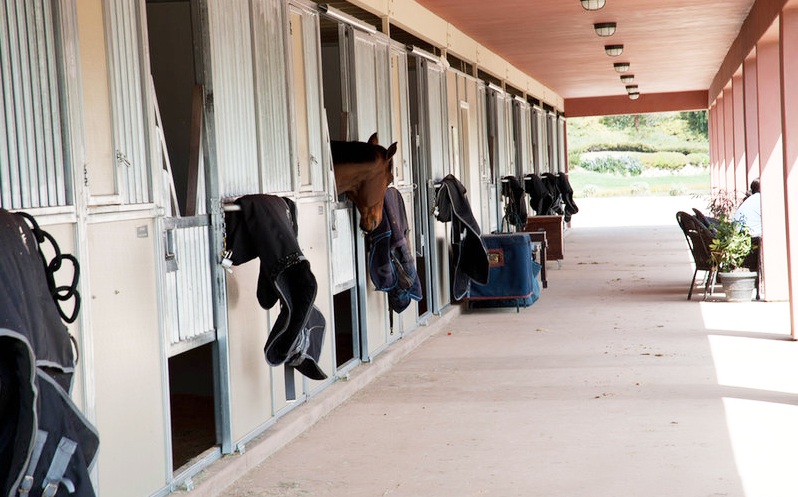
The $270 million property debuted
right at the start of the recession, but by then it
was already complete with elaborate gold wall flocking
and 22-carat gold door trim, acres of marble and
mahogany, hand-stenciled ceilings, twisting grand
staircases, and private cars sitting at the ready to
whisk guests the from the front lobby to the signature
Addison restaurant tucked in a 50,000 square foot
Spanish-style clubhouse down the hill.
I’ll be honest. Given my near
Puritanical upbringing, such places can make me feel a
little prickly. It can be difficult to relax when the
resort staff is sometimes better dressed than I am,
when politely uttered “m’am” and “monsieur” follow
guests everywhere they go, and old elegance threatens
to mesh so awkwardly with new money. Really, the
artwork in the spa’s ladies lounge includes framed
Hermés scarves.
But then I climbed aboard Showman,
a gorgeous, meticulously manicured bay gelding, and
headed out on the trail with stable owner and
professional show jumper Jessica Odom. She leases the
barn from the resort, and offers rides on a half-dozen
or so pedigreed animals ranging from a
personality-plus stocky black pony to a tall, sleek
gray thoroughbred rescued from a racetrack. How to
ride was my choice: western or English, and as we
meandered through desert brush spanning 37 miles of
colorful hills and valleys, she confided that when the
adjacent golf course is empty, she brings her horses
out to graze on some fringe stretches of grass and
simply soaks up the beauty around
her.
Prickly, be damned. It’s impossible
to not be smitten here.
Another “oh yeah” moment came
later, as I dozed off in what can best be described as
a waterbed cocoon during my Renaissance treatment at
the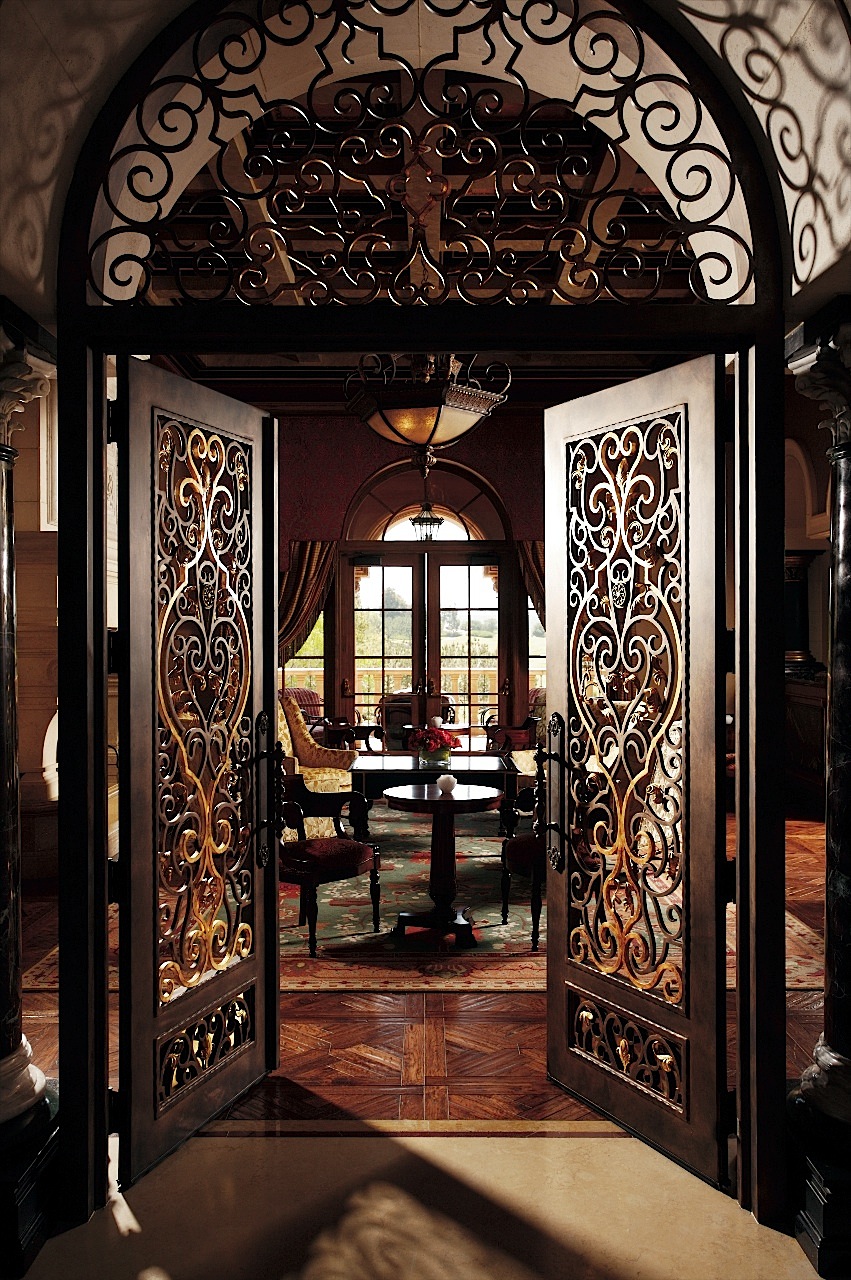 spa. I’d been slathered in
mineral-rich mud mixed with warmed aromatic oils,
mummified in a warm body wrap, and now bobbed quietly
in a free-floating bed that enveloped me like a loving
hug.
spa. I’d been slathered in
mineral-rich mud mixed with warmed aromatic oils,
mummified in a warm body wrap, and now bobbed quietly
in a free-floating bed that enveloped me like a loving
hug.
My therapist gently guided a detox
process, releasing what felt like decades of cramped
shoulder muscles from hunkering over a computer
keyboard. The goal, he softly explained as he set up
the rosemary-infused Swiss shower in my spa suite, is
to decompress on a daily basis. The final touch was a
long, stretching massage, and he gently flexed my
joints that had tightened a touch from my trail ride.
Not surprisingly, such relaxation
can be pricey. Fall rates start at $395 per night for
the 249 guestrooms and suites; the Renaissance
treatment is $320. Yet as I left the spa and wobbled
my way toward dinner, I felt like I’d been on vacation
for a month, even though I had just arrived that
morning.
While the rest of America is
seemingly racing towards casual comfort food – yes, I
do lament the loss of white tablecloths as we embrace
fried chicken - The Grand Del Mar’s flagship
restaurant, Addison, remains firmly rooted in
opulence, down to the cushioned stools offered as
purse rests and the more than $15 million tab it took
to put it all together. The look is old Europe meets
Taj Mahal, with Venetian plastered walls, black marble
columns and stone flooring, Moorish arches, limestone
fireplaces and a dramatic, inlaid ceiling.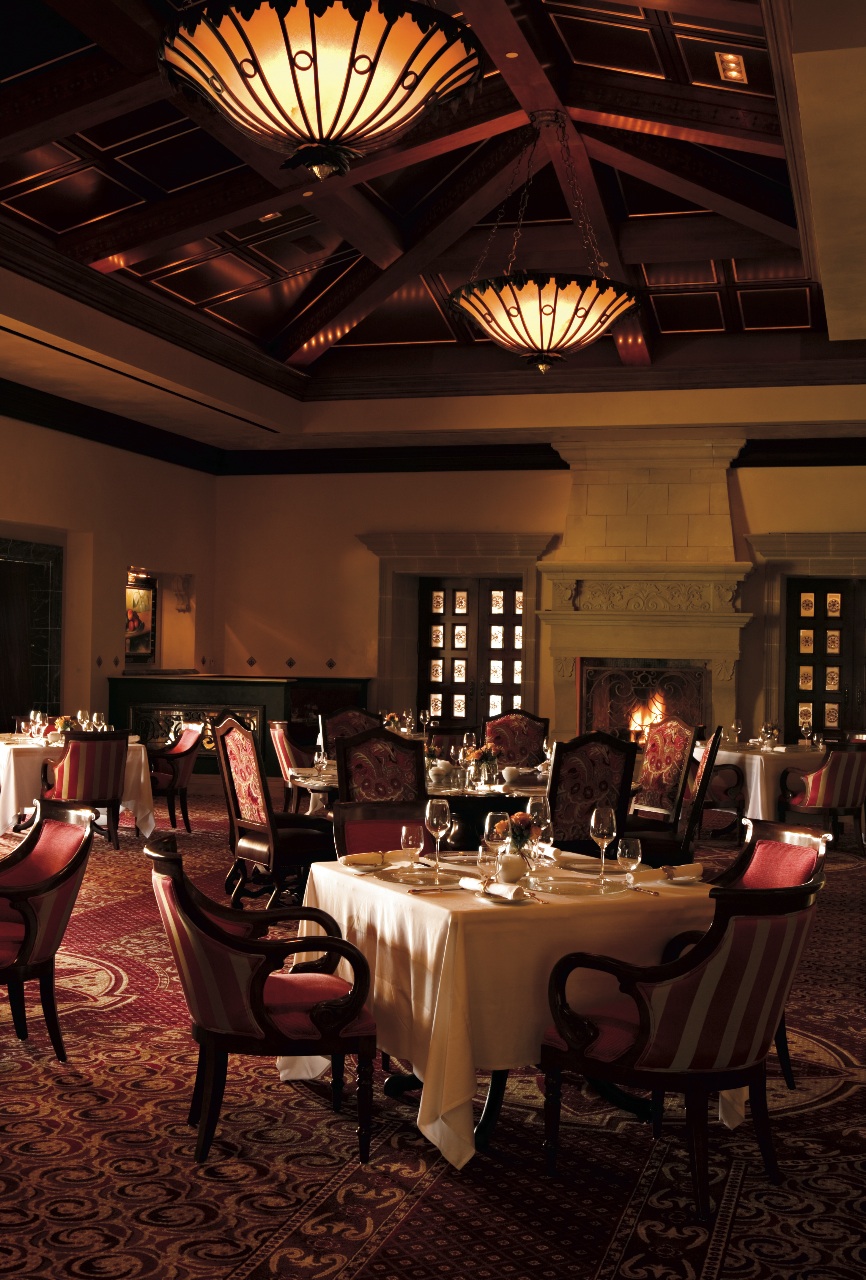
In such a setting, chef William
Bradley (below),
here since Addison opened, takes on the challenge of
creating cuisine that is as showstopping as the
extravagant chandeliers and the gold leaf capped
foyer. He succeeds by taking an opposite approach,
crafting a seasonal Cal-French menu that is complex,
careful, and often surprising with its flavors, yet
refreshingly simple.
In a multi-course menu tasting, we
began with a dainty bowl of calamari and mussels in a
subtle basil bouillabaisse. Then, it was on to
delicate nubbins of Alaskan King crab basking in
tarragon, lemon and vanilla Beurre d'Isigny from
Normandy, expertly balanced so that the fresh seafood
was the star of the plate.
The presentation for Australian hiramasa lightly
moistens the yellowtail kingfish with miso, adds the
crunch of cucumbers and radish, then finishes with a
wonderful jolt of pickled pears. Butter-baked broccoli
is an inventive bite, anointed with whipped white
cauliflower, rich uni,
and a note of curry. Flavors are clean and distinct
but unite wonderfully on the palate.
For a prix fixe meal, diners choose
a starter, an entrée and a dessert ($90),
adding another second course if they choose ($98). The
après-appetizer might be a creamy, impossibly
rich foie gras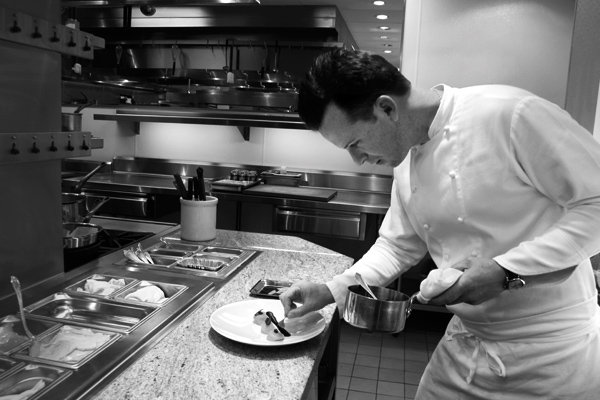 pot de crème
harmonizing with fennel pollen, a bracing bit of
orange and pain d’épices, or a graceful slab of
Atlantic sablefish dotted with black olive agnolotti
and garden pistou, or silky coddled farm egg washed in
green asparagus velouté and a smattering of
morels.
pot de crème
harmonizing with fennel pollen, a bracing bit of
orange and pain d’épices, or a graceful slab of
Atlantic sablefish dotted with black olive agnolotti
and garden pistou, or silky coddled farm egg washed in
green asparagus velouté and a smattering of
morels.
Servers glide to the table,
unobtrusively removing plates and resetting
silverware, and for each course, sommelier Jesse
Rodriguez unveils another wine, including vintages
made exclusively for the resort plus private bottlings
like a Weingut Leitz Magdalenenkreuz Riesling that is
deeply fragrant with citrus, green pear and apple.
He works with a myriad of flavors
and some 60 wines by the glass, for entrees like
slightly sweet, meaty licorice-glazed squab atop
candied red cabbage, plums and sauce albufera, or
earthy sweetbreads brightened with caramelized onions,
sharp Parmesan and morels.
Artisan breads are presented as if
we’re being offered jewelry, servers whisper “would
madam care for anything,” and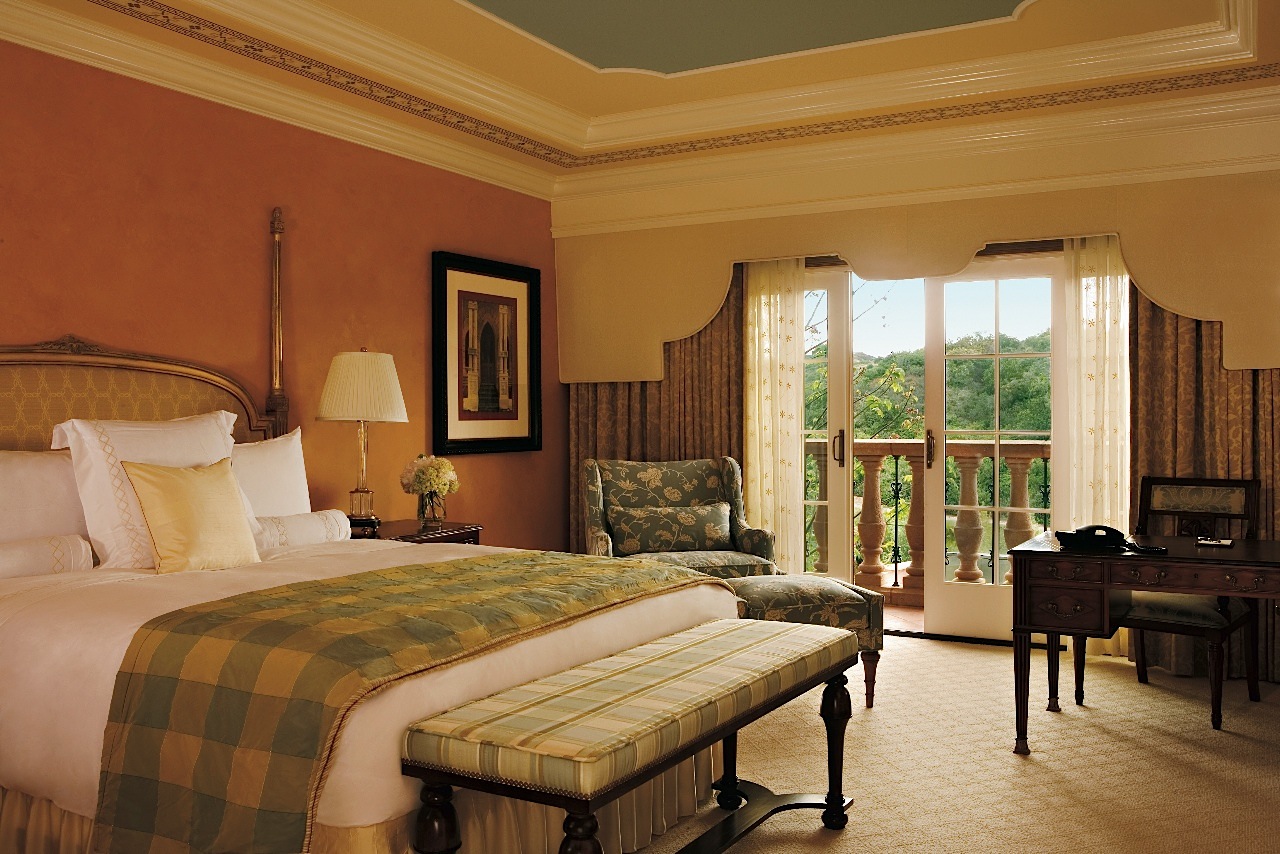 tables are
set so far apart if feels nearly like private dining.
Yet for its pomp, there is little pretension.
As I commented on the art of my
dessert, a portrait-worthy cake of caramelized banana
bread glistening with rum-raisin crème
glaçage, my server smiled.
tables are
set so far apart if feels nearly like private dining.
Yet for its pomp, there is little pretension.
As I commented on the art of my
dessert, a portrait-worthy cake of caramelized banana
bread glistening with rum-raisin crème
glaçage, my server smiled.
“Would madam like to see the
kitchen?” he asked.
It’s another highlight of an
Addison visit. Chef Bradley is a drill sergeant for a
clean, efficient operation – even as the kitchen is
large and the staff is busy, hand-plucking herbs,
tending long-simmered stocks, making and hand-wrapping
the caramels offered at meals’ end – the counters
gleam, the stovetops sparkle, and there isn’t a knife
out of place.
Settled back in my thousand-square
foot suite (right)
later that evening, sipping a nightcap of sparkling
wine on my secluded patio, I realized that yes, I
could quickly grow used to the swanky life. The sun
had set over the Carmel Valley hills, and the lights
of far-away homes glittered, vainly competing with the
glitter of stars in the sky. The cut crystal lamps in
my reading salon glowed softly, the European soaking
tub beckoned, and the plush pillow top bed with its
goose down pillows and Italian linens wooed me.
The Grand Del Mar is a
showcase of largesse. It speaks – no, it practically
screams – of privilege. And with its idyllic lure,
it’s calling my name to come back again and again.
NEW YORK
CORNER
by
John Mariani
Photos
by Noah Feck
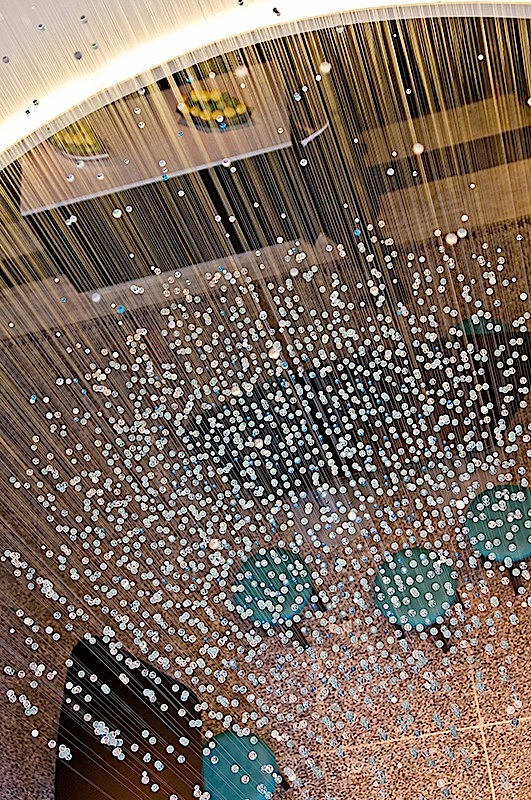
la mar cebicheria peruana
11
Madison Avenue (at 25th Street)
212-612-3388
www.lamarcebicheria.com
Unless you speak Spanish,
you probably don't want to try pronouncing the whole
name of La Mar Cebicheria Peruana, which the staff at
this two-week-old Peruvian restaurant shortens to an
easy to remember La Mar. It's a terrific-looking
place, on the premises of what had been the Indian
fusion restaurant Tabla, set on two floors, one
casual, the other no moreso except for its sleeker
look. The décor, by Stephanie Goto, who also
did Morimoto, Corton, and Aldea, includes a "rain
chandelier" within the huge oculus, with shimmering
colored glass beads that look very much like gentle
rain. A texture "corn wall" is made of 8,000 corn
kernels on pins. It's all quite something.
La Mar is the latest of 29 global
restaurants run by Chef Gastón Acurio, with
Victoriano Lopez serving in NYC as exec chef,
and N.A. Nadir, formerly at Japonais, as general
manager. Two weeks open, La Mar's well-versed service
staff is rushing to be amiable but has not yet got
timing in synch, leading to some delays in getting
drinks and wine, but I'm sure that will change with
time. The downstairs room is
very loud, as can the upstairs room turn if they punch
up the house music. Ask them to turn it down, and
you'll be able to converse easily.
Do check out the cocktail
menu, built around the Peruvian spirit
pisco, which goes into a delicious pisco sour. The
wine list, under sommelier Emmanuel Kemjii, is
extensive with New World (and Spanish) bottlings, and
mark-ups are not unreasonable.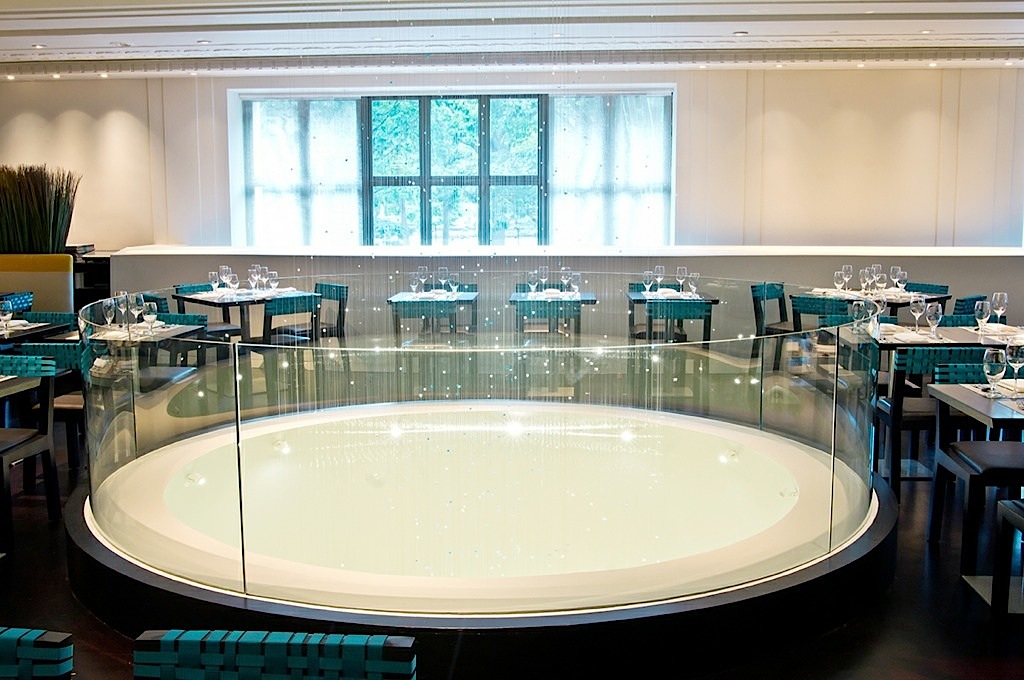
The full name of La Mar tells
you this is a place that focuses on cebiches
(ceviches), along with tiraditos (the
Peruvian
version of sashimi), causas (traditional
Peruvian
whipped potato dishes), platos criollos
(Peruvian entrées including fish, chicken,
steak, lamb and duck), and anticuchos (grilled
skewers). We left ourselves in the hands of the chef
to send out an array of dishes, which included two cebiches: "Elegance,"
made of warm water fluke with red onions,
Peruvian corn and yam in a leche de tigre ("tiger's milk," made
of lime juice, garlic, ginger, coconut milk, and
yellow peppers), and "Popular," a combo of salmon,
shrimp and tender octopus in a green leche de tigre
topped with crispy calamari. The quality and
tastiness, not to mention the beauty of the dish, are
enough to make you want to rip through the whole cebiche menu, but
there's much more to go.
The tiradito we tried was hamachi,
with Peruvian corn and scallions with creamy ají amarillo
leche de tigre, which unfortunately that
night was fairly fishy tasting.
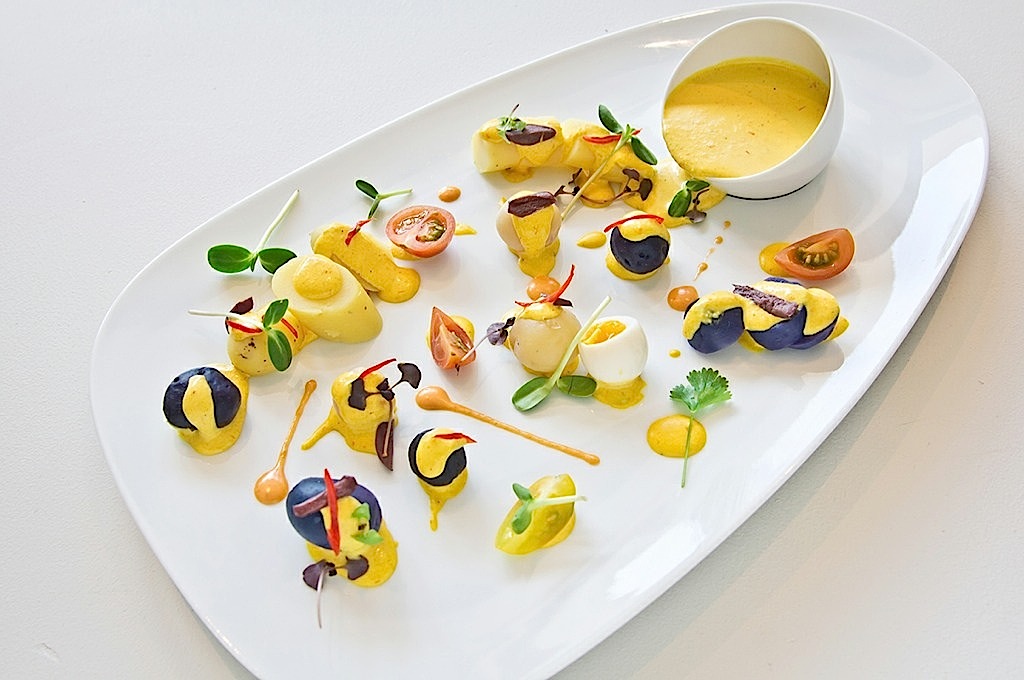 Peruvian
potatoes, which have been propagated for more than
5,000 years and were the first potatoes sent by the
Spanish explorers back to Europe, are done in myriad
ways. We had limeña,
whipped potatoes with a fishermen
escabeche, heirloom cherry tomatoes, avocado, ocopa sauce and
quail egg, a delightful dish. For our main
courses--and everything is served more or less in
small plate fashion with nothing costing more than
$16--was a velvety salmon belly with purple potatoes
and vinegar, and pastel
de choclo, a Peruvian corn cake with hon shimeji mushrooms
and choclo saltado,
a light yellow corn)--this went fast at our table,
and, had we not already eaten so much, and so well, I
would have ordered another round. We also enjoyed seco de cordero,
lamb shoulder and chop in a cilantro-squash sauce with
Peruvian
potatoes, which have been propagated for more than
5,000 years and were the first potatoes sent by the
Spanish explorers back to Europe, are done in myriad
ways. We had limeña,
whipped potatoes with a fishermen
escabeche, heirloom cherry tomatoes, avocado, ocopa sauce and
quail egg, a delightful dish. For our main
courses--and everything is served more or less in
small plate fashion with nothing costing more than
$16--was a velvety salmon belly with purple potatoes
and vinegar, and pastel
de choclo, a Peruvian corn cake with hon shimeji mushrooms
and choclo saltado,
a light yellow corn)--this went fast at our table,
and, had we not already eaten so much, and so well, I
would have ordered another round. We also enjoyed seco de cordero,
lamb shoulder and chop in a cilantro-squash sauce with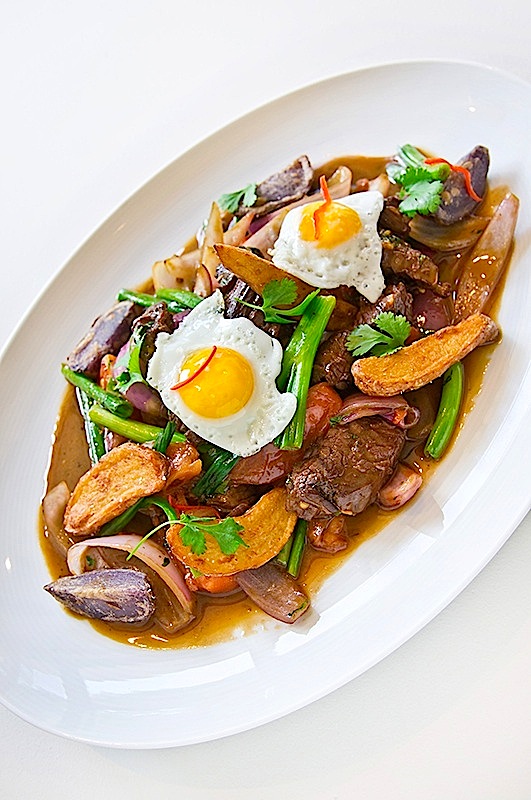 stewed white
canary beans and a salad of radishes; it's requisite
to have some beef on an American menu, so La Mar
serves lomo saltado
(right),
nice, chewy hanger steak with plenty of onions,
tomatoes, scallions, quail's egg, and French fries and
a side of corn.
stewed white
canary beans and a salad of radishes; it's requisite
to have some beef on an American menu, so La Mar
serves lomo saltado
(right),
nice, chewy hanger steak with plenty of onions,
tomatoes, scallions, quail's egg, and French fries and
a side of corn.
La Mar does not flinch when
it comes to desserts, which included lúcuma (a
subtropical Peruvian fruit often used in Incan art) y cacao on top
of crushed alfajores
(honeyed nuts) and queso
helado (white cheese ice cream); the
Peruvian fritters called picarones, spiced with chancaca honey;
and an array of very good passionfruit, tamarind and
raspberry sorbets.
Afterwards you might even want to
go downstairs to the bar and sample some piscos.
La Mar is a very welcome addition
to NYC's ethnic dining scene, for although there are
storefront Peruvian restaurants dotting the outer
boroughs, La Mar is serving what Señor Acurio
calls "Peruvian haute cuisine" in a glamorous setting,
and doing so all at good prices. If there is a strong
whiff of it being a corporate enterprise, La Mar is,
at least for now, unique in NYC and well worth going
to for a one-night education in this food
culture.

MAN ABOUT TOWN
by Christopher Mariani
PUT PIEDMONT ON YOUR SHORTLIST

I dine
in NYC often and have to say, it is the best city in
the United States for Italian food. There is an
endless list of terrific restaurants – Hearth, SD26,
Lincoln, Donatella, San Pietro, Fiorini, Marea,
Caravaggio and so many more, all offering great
Italian wines from different 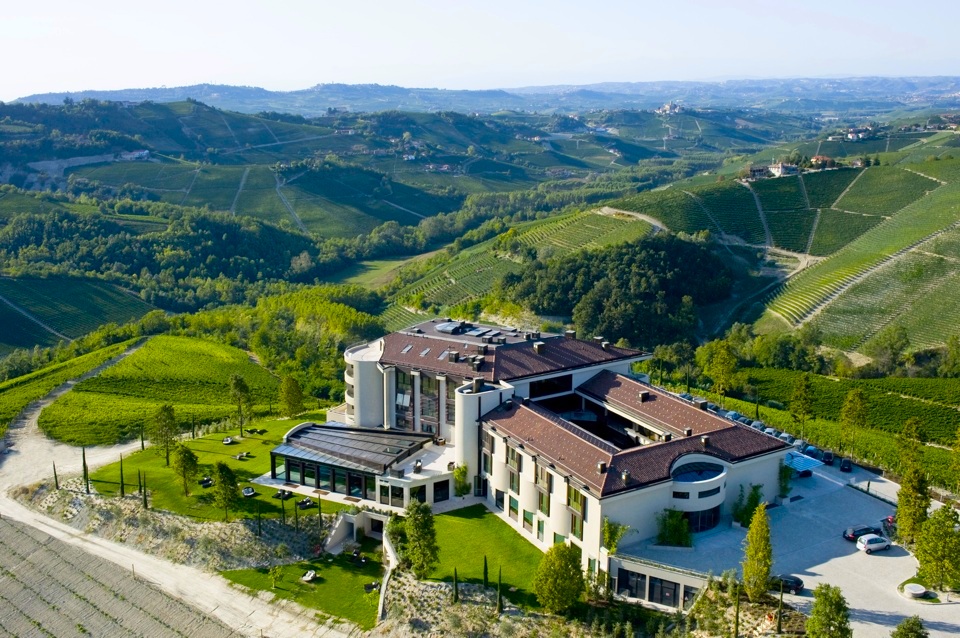 regions of Italy, which is
not surprising considering they are Italian
restaurants. What I have noticed over the past five
years is the increase of Italian wines, especially
from Piedmont, on wine lists of non-Italian
restaurants. Lusty Barolos and Barbarescos, along with
gentler Barberas, Dolcettos and the booming Moscato
d’Astis are now appearing in great numbers on wine
lists across the city and country. Some even say
Italian wines are conquering the world. So I
decided to check out Piedmont for myself.
regions of Italy, which is
not surprising considering they are Italian
restaurants. What I have noticed over the past five
years is the increase of Italian wines, especially
from Piedmont, on wine lists of non-Italian
restaurants. Lusty Barolos and Barbarescos, along with
gentler Barberas, Dolcettos and the booming Moscato
d’Astis are now appearing in great numbers on wine
lists across the city and country. Some even say
Italian wines are conquering the world. So I
decided to check out Piedmont for myself.
It had been way too long--six weeks--since I
had last visited Italy, so I headed for Milan.
During my flight I drank some wine, read some
Hemingway, drifted off to sleep and tried to imagine
what Piedmont would look like. Spending much time in
Tuscany, I assumed the landscape would be somewhat
similar. I could not have been more wrong about that
assumption. Tuscany is as gorgeous as Italy gets but
is exactly what comes to mind when you think of
Italian wine country. Piedmont is like stepping onto a
different planet. The terrain is particularly steep,
the hills are covered by the brightest green
imaginable, the type you see when you open a National Geographic,
and besides the vines, there is not much else. I can
assure you the region now, looks exactly as it
did 200 years ago. Outside of Turin and its
other cities, Piedmont is untouched. Here is a place
you can 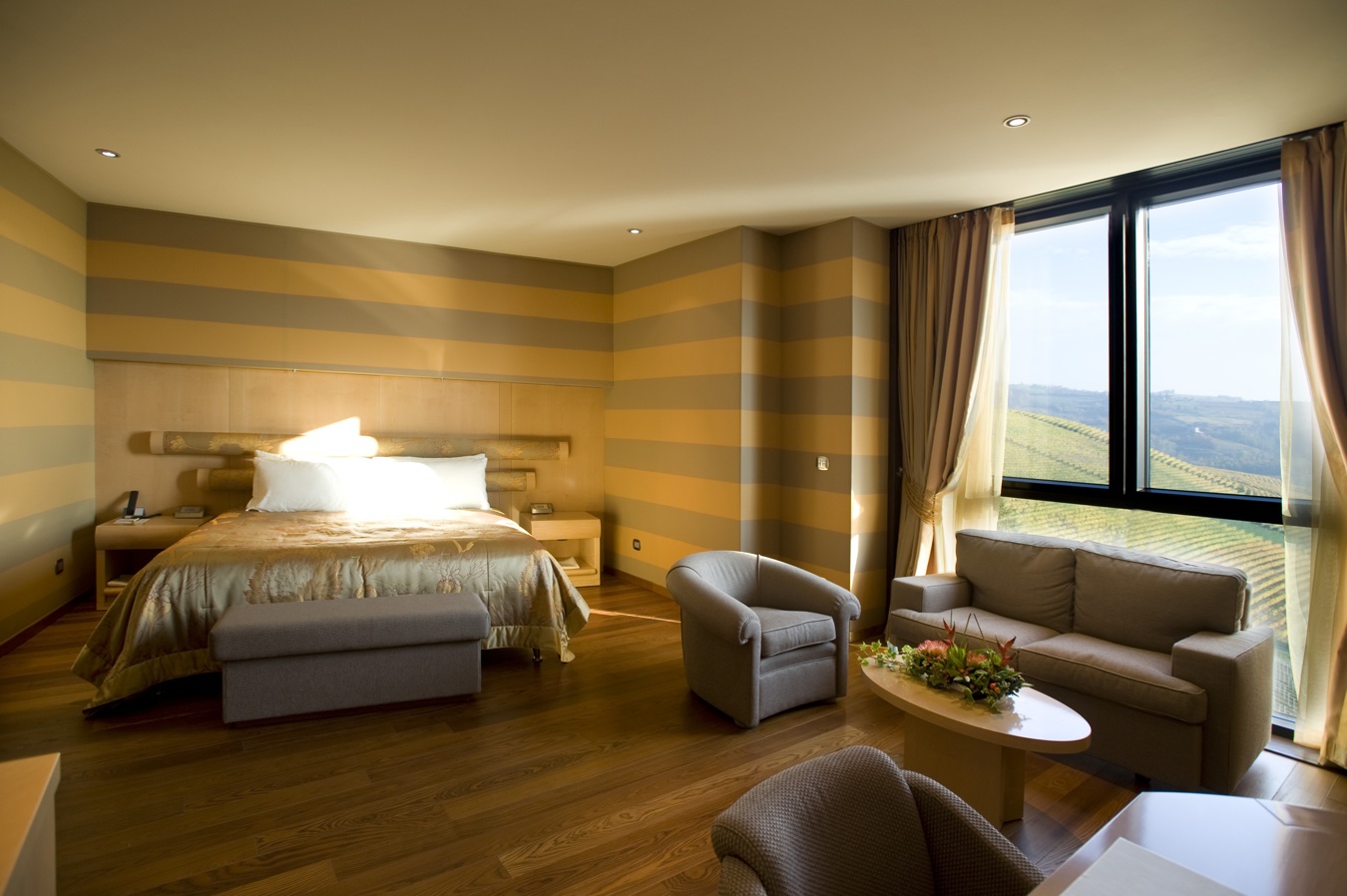 go to appreciate the natural beauty God
gave Piedmont after practicing on the rest of it,
bolstered by the addition of hundreds of vineyards
blanketing the landscape as far as the eye can see. On
a clear day, you can even see the Alps peeking up in
the distance, almost grazing the clouds. This is what
makes Piedmont one of, if not the most beautiful
regions in all of Italy.
go to appreciate the natural beauty God
gave Piedmont after practicing on the rest of it,
bolstered by the addition of hundreds of vineyards
blanketing the landscape as far as the eye can see. On
a clear day, you can even see the Alps peeking up in
the distance, almost grazing the clouds. This is what
makes Piedmont one of, if not the most beautiful
regions in all of Italy.
Once in Milan (which is in
Lombardy), I got into a car and headed straight for
the hills, where I would be staying at the Il
Boscareto Resort and Spa (above). When we arrived, a two-hour
drive from Milan, I noticed the vineyards, even though
lush green and abundant with grape clusters, were
unoccupied by a single human being. The driver
informed me the DOC and the DOCG Italian wine laws
have such strict regulations on growing grapes that
the growers just let nature take its course. Unlike
most other wine producing countries in the world,
Italy’s DOC and DOCG does not allow for irrigation
once the vines have matured. The driver went on to
say, “We wait for the rain and see what happens. Too
much rain, our wine is lousy but our white truffles
are plentiful. Less rain yields better wine but fewer
truffles.” He then went on to say, “Either way, we eat
and drink well year round.” That put a smile on face.
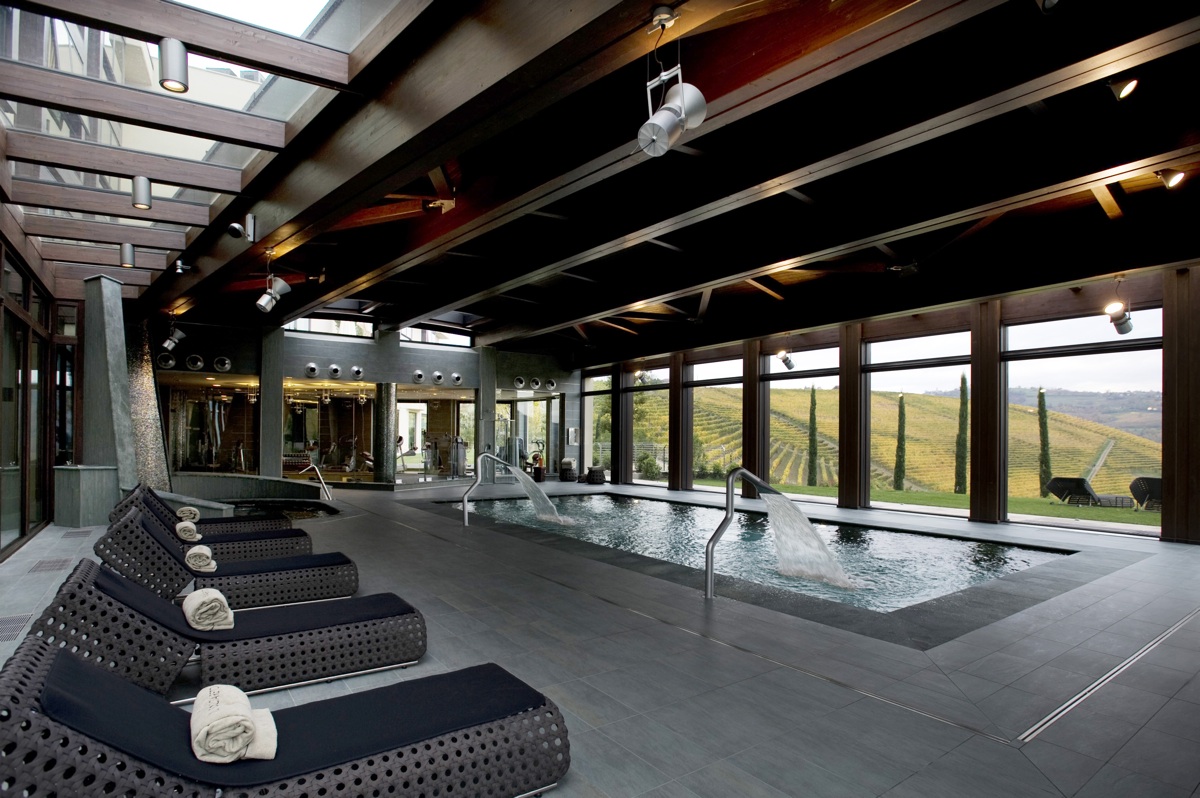 After winding through
the hills on a two-way road that barely allowed for
one car, we arrived at Il Boscareto. Parked in the
driveway was a charcoal grey Ferrari 599, a red DBS
Volante Aston Martin convertible, a white Lamborghini
Gallardo, and a the new 525-horsepower Audi R8, and
yet, for the first time in my life I wasn’t impressed.
I was too busy gazing out at the stunning view of the
Langhe, an area of Piedmont known for growing the
Nebbiolo grape. Il Boscareto sits on one of the
highest elevations in the region and looks down into
the valley below and across the way to neighboring
vineyards, small villas and the occasional stone
castle. The air is the crisp, the only sound was the
gentle wind, and the smell of fresh air was
everywhere. Immediately, I walked inside and was
greeted with a glass of Barbera d’Alba, which I
quickly found out to be the region’s everyday drinking
wine, especially with lunch, after a few glasses of
white Gavi and Arneis.
After winding through
the hills on a two-way road that barely allowed for
one car, we arrived at Il Boscareto. Parked in the
driveway was a charcoal grey Ferrari 599, a red DBS
Volante Aston Martin convertible, a white Lamborghini
Gallardo, and a the new 525-horsepower Audi R8, and
yet, for the first time in my life I wasn’t impressed.
I was too busy gazing out at the stunning view of the
Langhe, an area of Piedmont known for growing the
Nebbiolo grape. Il Boscareto sits on one of the
highest elevations in the region and looks down into
the valley below and across the way to neighboring
vineyards, small villas and the occasional stone
castle. The air is the crisp, the only sound was the
gentle wind, and the smell of fresh air was
everywhere. Immediately, I walked inside and was
greeted with a glass of Barbera d’Alba, which I
quickly found out to be the region’s everyday drinking
wine, especially with lunch, after a few glasses of
white Gavi and Arneis.
Il Boscareto is the one and only
five-star luxury resort in the area and hopes to spark
increased tourism to Piedmonte. They are the pioneers
of the region and have taken a huge gamble on what
they predict to be something amazing. Unlike Tuscany,
where thousands of tourists flood, Piedmont receives
minimal travelers from Northern Italy, most of whom
drive out for a day trip of wine tasting. The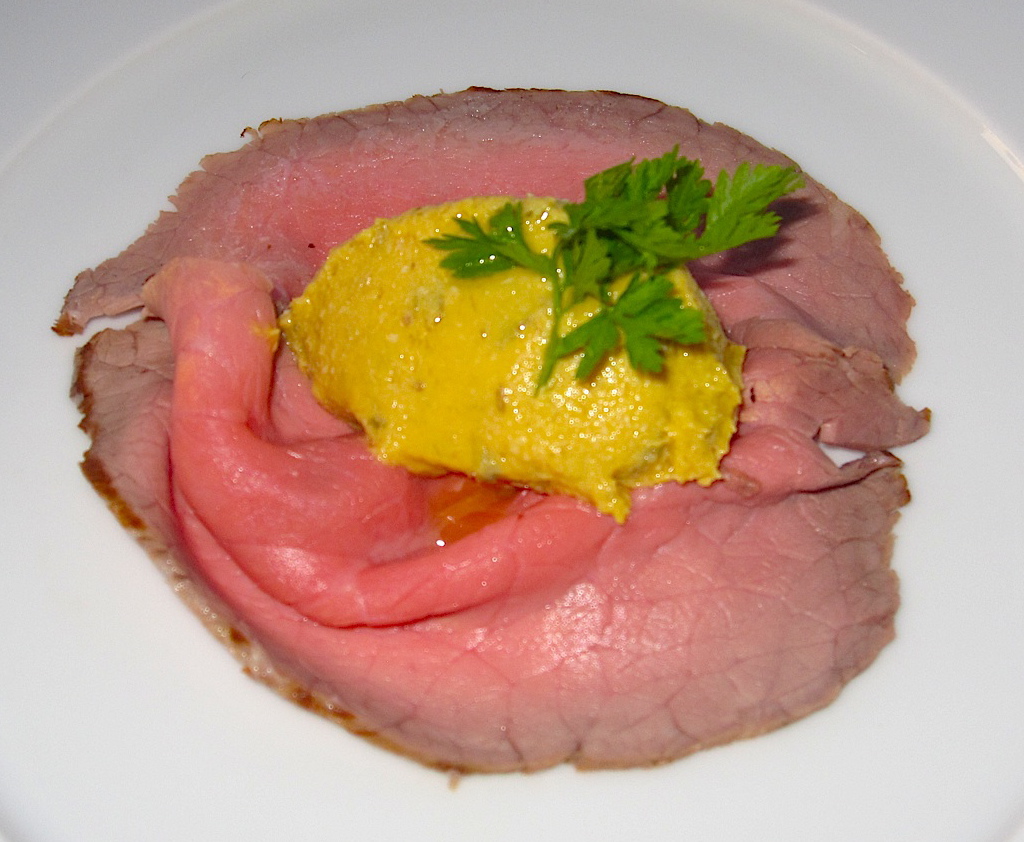 problem is, there really
isn’t anywhere to stay. Of course you can rent out a
room in an Italian villa, similar to a bed and
breakfast, which I think is absolutely charming, but
prior to Il Boscareto there were no luxurious hotels.
And yes, Il Boscareto is getting a lot of resentment
from the region because they are first to do so, but
their intentions are to build awareness to Piedmont
and make it more of a destination than just a section
of Italy that is known for making great wine.
problem is, there really
isn’t anywhere to stay. Of course you can rent out a
room in an Italian villa, similar to a bed and
breakfast, which I think is absolutely charming, but
prior to Il Boscareto there were no luxurious hotels.
And yes, Il Boscareto is getting a lot of resentment
from the region because they are first to do so, but
their intentions are to build awareness to Piedmont
and make it more of a destination than just a section
of Italy that is known for making great wine.
The resort itself is magnificent
and offers every lavish amenity one could wish for –
an indoor/outdoor pool (above), a modern fitness center, a
deluxe spa, two of the finest restaurants in the
region, elegantly designed rooms with gorgeous views,
and best of all, a grass lounge where I spent most of
my time sipping on a glass of Barbera while sprawled
out on a B&B Italia canasta circular sofa looking
through scattered cypress trees out onto miles of
picturesque wine vineyards.
That evening I dined
at the hotel’s premiere restaurant, La Rei, run by
Gianpiero Vivaldo. The restaurant sits on the second
floor of the property and has tables set outside
underneath umbrellas where the sun sets around 7 pm,
right before the night sky fills with bright stars.
After a little antipasti and a bottle of Gavi I had my
first taste of vitello
tonnato (right),
a dish native to Piedmont and served at every single
restaurant in the region. Vitello tonnato is braised veal,
sliced thin like American roast beef and topped with a
tuna sauce, with a similar consistency to mayonnaise.
The night continued with roasted rabbit loin, followed
by two orders of homemade pasta. 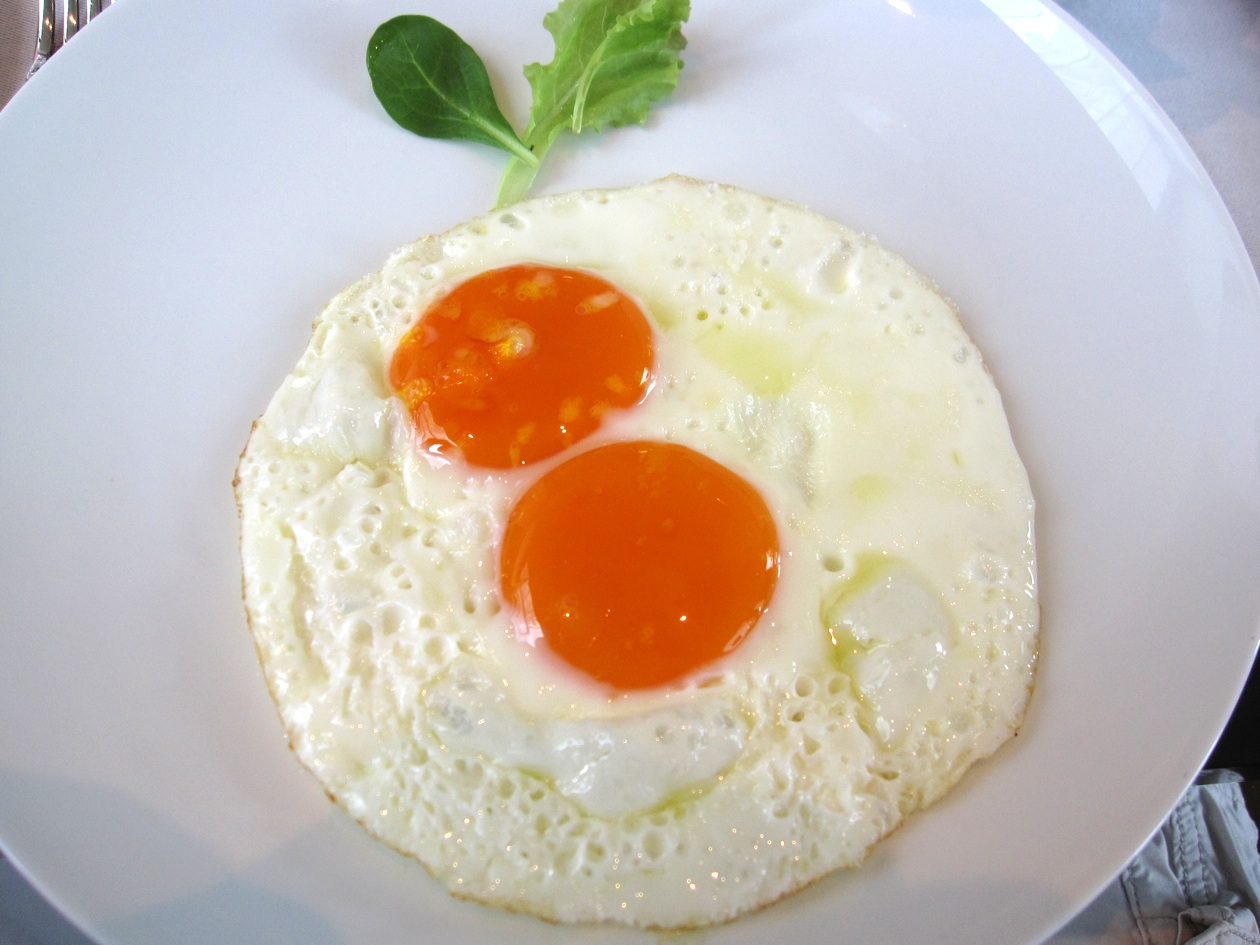 I finished off
the evening with the company of a few new friends at
the Sunsi Bar inside the hotel for good conversation
and a glass of 1985 grappa.
I finished off
the evening with the company of a few new friends at
the Sunsi Bar inside the hotel for good conversation
and a glass of 1985 grappa.
The following morning, I walked
downstairs and had a cappuccino and two fried eggs (left). I’ve never
seen such intense orange yolks in my entire life. They
didn’t even look real. The eggs alone are worth a trip
to Italy.
For the remainder of the week, I
toured the region, tasted some terrific Dolcetto wine,
ate lots of risotto with chopped pancetta and parmesan
cheese, homemade ravioli filled with pork and veal,
and lots more vitello
tonnato.
Piedmont remains, for the
moment, a section of Italy that many people have heard
about but few have visited unless they've been to
Turin on business. But the wines, the natural beauty
and the food of Piedmont are among the best in all of
Italy. The Piedmontese know it and until recently have
kept it pretty much to themselves. But I'm happy to
spread the news of its beauty and of Il Boscaretto,
which can easily spoil you right at the start.
ARE NOW MAKING DISTINCTIVE WHITE WINES
by John Mariani
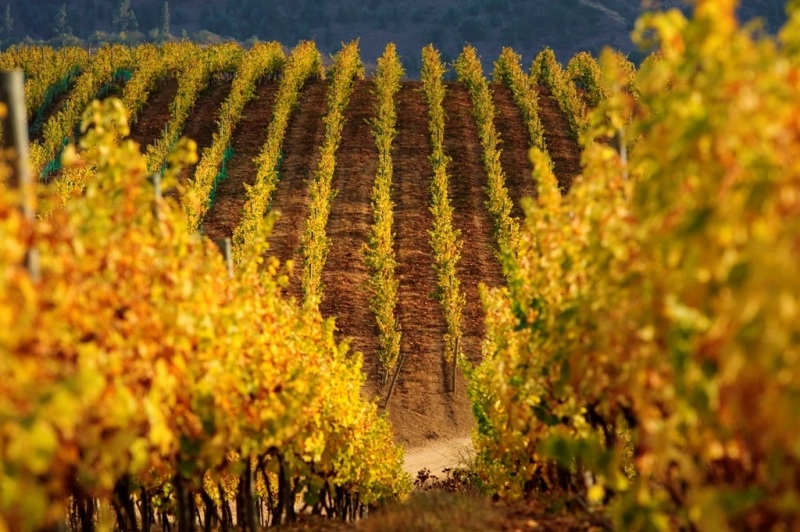 Quick: name a good white wine from
Chile. Stumped? I’m not surprised.
Quick: name a good white wine from
Chile. Stumped? I’m not surprised.
For while the wine
industry and media—myself included--have poured
tremendous attention and praise on the red wines
of Chile over the last decade, the country’s white
wines go relatively unnoticed. Overwhelmingly
the whites are made from either sauvignon blanc,
with 12,159 hectares planted, or chardonnay, with
13,082, along with few thousand hectares of
semillon, viognier, riesling and
gewürztraminer. Sauvignon blanc is, after
cabernet sauvignon, Chile’s second strongest
varietal, with sales of $9,140,725 this year, an
8.6 percent increase from last year.
San Antonio Valley Vineyards
Still, quality wines from such
white varietals are of very recent origins, since
prior Socialist government land restrictions and the
sheer isolation of the vineyards in the western
mountains made for high-volume mediocrity, mostly from
the pais grape planted by Spanish missionaries.
Only in the 1980s did Chile develop a modern
wine industry and did so fast, with access to the best
new technologies of viticulture, in one important
instance led by Spanish wine producer Miguel Torres,
who planted grapes in the Curico Valley in 1979.
Over the last few weeks I have tasted a wide
range of Chilean whites—on their own and then with
food—and, overall, found a quality level I’d rank at
or above the same varietals from New Zealand and
California. While some of the Chilean sauvignon blancs
mimicked the overly grassy, vegetal smell and taste of
New Zealand and California examples, many others
showed a remarkable breeding for an industry so young. All were
cleanly made, with few trying to impress by high
alcohol and overripened fruit flavors.
Many, as is common in Chile, have
screwcaps, for while some winemakers may debate the
merits of cork stoppers over screwcaps for red wines,
the latter are clearly better--and easier to
open--when it comes to white wines to be drunk within
a year or two of release. Here are some of those I
most enjoyed.
Vision Cono Sur
Sauvignon Blanc 2010 ($12-$14)—From the
Casablanca Valley, with rich mineral clay soil, this
exhibits a true sauvignon blanc nose with minerals and
new grass, still pretty vegetal on the finish. It
flourishes with foods like chicken and corn.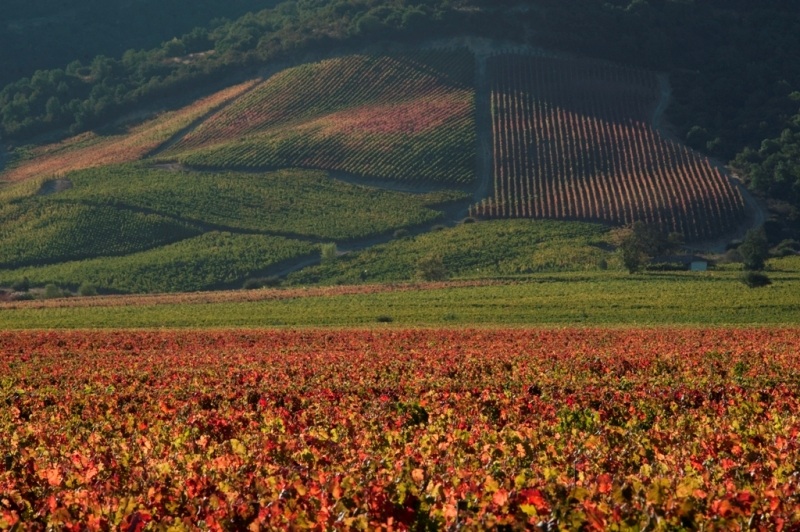
Casas del Bosque Reserva
Sauvignon Blanc 2010 ($15)—From this
family-owned estate in the Casablanca Valley comes a
green-yellow wine with lots of body, the fragrance of
litchi, and the pronounced tang of lemony fruit and
good acid, which was perfect with a lunch I had of
just-picked tomatoes, mozzarella, bread, and olive
oil.
Palo Alto Sauvignon Blanc Reserva 2009
($13)—Very pale green-gold color, with both nose and
flavors more herbaceous and mineral than grassy, very
close in style to a Loire Valley Sancerre and
therefore ideal with simple seafood, especially shrimp
and lobster.
EQ Sauvignon Blanc Matetic Vineyards 2010
($20)—Made according to principles of biodynamic in
Valle de Rosario vineyards, this is a sauvignon blanc
with plenty of vigor, not least a delightful minty
finish. Of more than a dozen sauvignon blancs I
tasted, this to me seemed to have something
distinctive that might indicate the future expression
of the Chilean terroir.
Colchagua Valley Vineyards
Sol de Sol Chardonnay 2008 ($10)—Indeed, this
is a sunny wine from the Malleco Valley, and a little
age has bolstered its lovely bouquet and chardonnay
flavor that I associate with some of the lighter
examples from Burgundy’s Cote d’Or, which is hardly
surprising since three of its four owners are French
winemakers—Paul Potaillier, Bruno Prats, and Ghislain de
Montgolfier; the fourth is Chilean enologist Felipe de
Solminihac. I enjoyed this with Chinese noodles whose
soy sauce, ginger, and pepper were fully complemented
by this splendid wine.
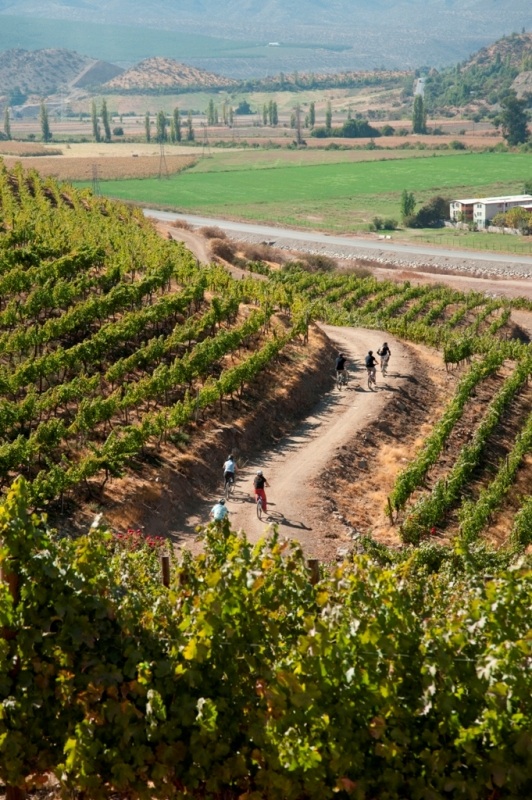
Leyda Lot 5 Wild Yeasts Chardonnay 2008 ($20)—Only
500 cases are made of this Leyda Valley wine, and it’s
not very convincing as a chardonnay, but its brisk
acid and tang made it a capital choice with a beef
frankfurter layered with sauerkraut, mustard, and
horseradish.
Marques
Casa Concha Chardonnay 2009 ($20)—Made by the
huge Concha y Toro wine company, this is a chardonnay
for those that like them gutsy, with lots of vanilla,
a decent amount of oak, and 14 percent alcohol. It’s quite
a mouthful, excellent with spicy food.
Eco
Balance Chardonnay Emiliana Vineyards 2010
($9)—It sounds like a jogging sure, but this is a very
good buy for a wine from organic, sustainable
vineyards whose acronymic name stands both for Ecology
and for “Enjoy Life to the Fullest, Care for the World
Around You, and Open and Share with Family and
Friends,” lovely sentiments for a big, 14 percent
alcohol charmer that seems an honest marriage of
California boldness and French earthiness.
Aconcagua Valley Vineyards
John Mariani's wine column appears in Bloomberg Muse News, from which this story was adapted. Bloomberg News covers Culture from art, books, and theater to wine, travel, and food on a daily basis.
❖❖❖
BUT FIRST JAPANS NEEDS
A SPACE TRAVEL PROGRAM

Domino's
Pizza's Japanese arm has plans to build
a restaurant on the moon at a cost of
 "`RedFarm'— what does that
even imply, a collectivist farm in Mao’s China? It’s
certainly ironic enough, considering how RedFarm
wallows with such relish in the rectal expulsions of
capitalism. . . .Everyone forgets about “The Chinese
Probrem” though once the cops arrest Steven
Spielberg and George Lucas for raping Indiana Jones.
The episode satirizes paranoid sterilizations of
Chinese cultures and the Hollywood impulse to
squeeze profit from absurd gimmicks. It’s easy to
substitute RedFarm for Cartman’s P.F. Chang’s.
Wherever RedFarm winks at stereotype and
`multiculturalism,' it propagates colonial power
structures. Wherever RedFarm juxtaposes incongruent
culinary tropes or draws on popular culture, it
participates in the limitless homogenization of
`Asian' culture. RedFarm’s brazen absorption
of “Oriental” cooking techniques into a dim sum
mythology validates our fixation on conspicuous,
colonial consumption. In effect, RedFarm is
reeducating New Yorkers to ignore the complex
externalities of transnationalism; to reduce the
world outside Manhattan to a flickering cosmorama;
to diminish those still colonized to an artifact of
gustatory entertainment; to gleefully anal probe the
margins of the colonial map. Such is the agenda of
many Manhattan restaurants. RedFarm merely has the
misfortune of being a particularly obvious
offender."--Jason Bell, "Redfarm," Columbia Daily
Spectator.
"`RedFarm'— what does that
even imply, a collectivist farm in Mao’s China? It’s
certainly ironic enough, considering how RedFarm
wallows with such relish in the rectal expulsions of
capitalism. . . .Everyone forgets about “The Chinese
Probrem” though once the cops arrest Steven
Spielberg and George Lucas for raping Indiana Jones.
The episode satirizes paranoid sterilizations of
Chinese cultures and the Hollywood impulse to
squeeze profit from absurd gimmicks. It’s easy to
substitute RedFarm for Cartman’s P.F. Chang’s.
Wherever RedFarm winks at stereotype and
`multiculturalism,' it propagates colonial power
structures. Wherever RedFarm juxtaposes incongruent
culinary tropes or draws on popular culture, it
participates in the limitless homogenization of
`Asian' culture. RedFarm’s brazen absorption
of “Oriental” cooking techniques into a dim sum
mythology validates our fixation on conspicuous,
colonial consumption. In effect, RedFarm is
reeducating New Yorkers to ignore the complex
externalities of transnationalism; to reduce the
world outside Manhattan to a flickering cosmorama;
to diminish those still colonized to an artifact of
gustatory entertainment; to gleefully anal probe the
margins of the colonial map. Such is the agenda of
many Manhattan restaurants. RedFarm merely has the
misfortune of being a particularly obvious
offender."--Jason Bell, "Redfarm," Columbia Daily
Spectator.
 |
My latest book, written with Jim Heimann and Steven Heller, Menu Design in America, 1850-1985 (Taschen Books), has just appeared, with nearly 1,000 beautiful, historic, hilarious, sometimes shocking menus dating back to before the Civil War and going through the Gilded Age, the Jazz Age, the Depression, the nightclub era of the 1930s and 1940s, the Space Age era, and the age when menus were a form of advertising in innovative explosions of color and modern design. The book is a chronicle of changing tastes and mores and says as much about America as about its food and drink.
“Luxuriating vicariously in the pleasures of this book. . . you can’t help but become hungry. . .for the food of course, but also for something more: the bygone days of our country’s splendidly rich and complex past. Epicureans of both good food and artful design will do well to make it their cofee table’s main course.”—Chip Kidd, Wall Street Journal.
“[The menus] reflect the amazing craftsmanship that many restaurants applied to their bills of fare, and suggest that today’s restaurateurs could learn a lot from their predecessors.”—Rebecca Marx, The Village Voice.
“Restaurateurs, take note: A resurgence in thoughtful, artistic menus is past due.”—Bon Appetit Magazine |
Any of John Mariani's
books below may be ordered from amazon.com.
"Eating Italian will never be the same after reading John Mariani's entertaining and savory gastronomical history of the cuisine of Italy and how it won over appetites worldwide. . . . This book is such a tasteful narrative that it will literally make you hungry for Italian food and arouse your appetite for gastronomical history."--Don Oldenburg, USA Today. "Italian
restaurants--some good, some glitzy--far
outnumber their French rivals. Many of
these establishments are zestfully described
in How Italian Food Conquered the World, an
entertaining and fact-filled chronicle by
food-and-wine correspondent John F.
Mariani."--Aram Bakshian Jr., Wall Street
Journal.
"Equal parts
history, sociology, gastronomy, and just
plain fun, How Italian Food Conquered the
World tells the captivating and delicious
story of the (let's face it) everybody's
favorite cuisine with clarity, verve and
more than one surprise."--Colman Andrews,
editorial director of The Daily
Meal.com. "A fantastic and fascinating
read, covering everything from the influence
of Venice's spice trade to the impact of
Italian immigrants in America and the
evolution of alta cucina. This book will
serve as a terrific resource to anyone
interested in the real story of Italian
food."--Mary Ann Esposito, host of PBS-TV's
Ciao
Italia. "John Mariani has written the
definitive history of how Italians won their
way into our hearts, minds, and
stomachs. It's a story of pleasure over
pomp and taste over technique."--Danny Meyer,
owner of NYC restaurants Union Square Cafe,
Gotham Bar & Grill, The Modern, and
Maialino.
|
 |
 |
 |
 |
 |
 |
 |
 |
 Everett Potter's Travel Report:
Everett Potter's Travel Report: 
 Eating Las Vegas
is the new on-line site for Virtual Gourmet
contributor John A. Curtas., who since 1995
has been commenting on the Las Vegas food
scene and reviewing restaurants for Nevada
Public Radio. He is also the
restaurant critic for KLAS TV, Channel 8 in
Las Vegas, and his past reviews can be
accessed at KNPR.org.
Click on the logo below to go directly to
his site.
Eating Las Vegas
is the new on-line site for Virtual Gourmet
contributor John A. Curtas., who since 1995
has been commenting on the Las Vegas food
scene and reviewing restaurants for Nevada
Public Radio. He is also the
restaurant critic for KLAS TV, Channel 8 in
Las Vegas, and his past reviews can be
accessed at KNPR.org.
Click on the logo below to go directly to
his site.

Tennis Resorts Online: A Critical Guide to the World's Best Tennis Resorts and Tennis Camps, published by ROGER COX, who has spent more than two decades writing about tennis travel, including a 17-year stretch for Tennis magazine. He has also written for Arthur Frommer's Budget Travel, New York Magazine, Travel & Leisure, Esquire, Money, USTA Magazine, Men's Journal, and The Robb Report. He has authored two books-The World's Best Tennis Vacations (Stephen Greene Press/Viking Penguin, 1990) and The Best Places to Stay in the Rockies (Houghton Mifflin, 1992 & 1994), and the Melbourne (Australia) chapter to the Wall Street Journal Business Guide to Cities of the Pacific Rim (Fodor's Travel Guides, 1991).


The Family Travel Forum - A
community for those who "Have Kids, Still Travel" and
want to make family vacations more fun, less work and
better value. FTF's travel and parenting features,
including reviews of tropical and ski resorts, reunion
destinations, attractions, holiday weekends, family
festivals, cruises, and all kinds of vacation ideas
should be the first port of call for family vacation
planners. http://www.familytravelforum.com/index.html
ALL YOU NEED BEFORE YOU GO


MARIANI'S VIRTUAL GOURMET
NEWSLETTER is published weekly. Editor/Publisher: John
Mariani.
Contributing Writers: Christopher Mariani, Robert Mariani,
John A. Curtas, Edward Brivio, Mort Hochstein,
Suzanne Wright, and Brian Freedman. Contributing
Photographers: Galina Stepanoff-Dargery,
Bobby Pirillo. Technical Advisor: Gerry McLoughlin.
© copyright John Mariani 2011
